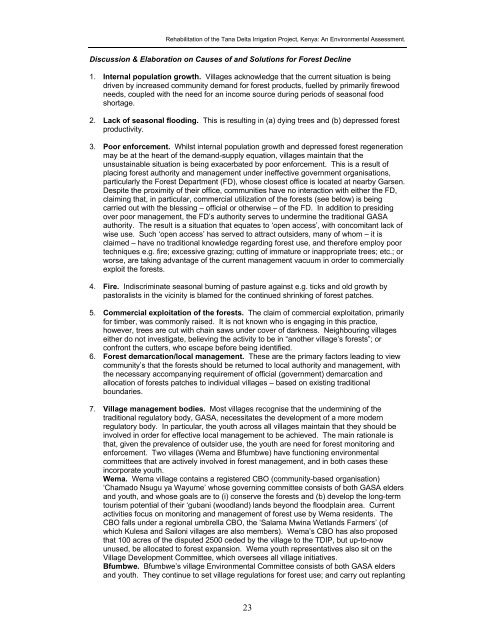Tana Delta Irrigation Project, Kenya: An Environmental Assessment
Tana Delta Irrigation Project, Kenya: An Environmental Assessment
Tana Delta Irrigation Project, Kenya: An Environmental Assessment
You also want an ePaper? Increase the reach of your titles
YUMPU automatically turns print PDFs into web optimized ePapers that Google loves.
Rehabilitation of the <strong>Tana</strong> <strong>Delta</strong> <strong>Irrigation</strong> <strong>Project</strong>, <strong>Kenya</strong>: <strong>An</strong> <strong>Environmental</strong> <strong>Assessment</strong>.<br />
Discussion & Elaboration on Causes of and Solutions for Forest Decline<br />
1. Internal population growth. Villages acknowledge that the current situation is being<br />
driven by increased community demand for forest products, fuelled by primarily firewood<br />
needs, coupled with the need for an income source during periods of seasonal food<br />
shortage.<br />
2. Lack of seasonal flooding. This is resulting in (a) dying trees and (b) depressed forest<br />
productivity.<br />
3. Poor enforcement. Whilst internal population growth and depressed forest regeneration<br />
may be at the heart of the demand-supply equation, villages maintain that the<br />
unsustainable situation is being exacerbated by poor enforcement. This is a result of<br />
placing forest authority and management under ineffective government organisations,<br />
particularly the Forest Department (FD), whose closest office is located at nearby Garsen.<br />
Despite the proximity of their office, communities have no interaction with either the FD,<br />
claiming that, in particular, commercial utilization of the forests (see below) is being<br />
carried out with the blessing – official or otherwise – of the FD. In addition to presiding<br />
over poor management, the FD’s authority serves to undermine the traditional GASA<br />
authority. The result is a situation that equates to ‘open access’, with concomitant lack of<br />
wise use. Such ‘open access’ has served to attract outsiders, many of whom – it is<br />
claimed – have no traditional knowledge regarding forest use, and therefore employ poor<br />
techniques e.g. fire; excessive grazing; cutting of immature or inappropriate trees; etc.; or<br />
worse, are taking advantage of the current management vacuum in order to commercially<br />
exploit the forests.<br />
4. Fire. Indiscriminate seasonal burning of pasture against e.g. ticks and old growth by<br />
pastoralists in the vicinity is blamed for the continued shrinking of forest patches.<br />
5. Commercial exploitation of the forests. The claim of commercial exploitation, primarily<br />
for timber, was commonly raised. It is not known who is engaging in this practice,<br />
however, trees are cut with chain saws under cover of darkness. Neighbouring villages<br />
either do not investigate, believing the activity to be in “another village’s forests”; or<br />
confront the cutters, who escape before being identified.<br />
6. Forest demarcation/local management. These are the primary factors leading to view<br />
community’s that the forests should be returned to local authority and management, with<br />
the necessary accompanying requirement of official (government) demarcation and<br />
allocation of forests patches to individual villages – based on existing traditional<br />
boundaries.<br />
7. Village management bodies. Most villages recognise that the undermining of the<br />
traditional regulatory body, GASA, necessitates the development of a more modern<br />
regulatory body. In particular, the youth across all villages maintain that they should be<br />
involved in order for effective local management to be achieved. The main rationale is<br />
that, given the prevalence of outsider use, the youth are need for forest monitoring and<br />
enforcement. Two villages (Wema and Bfumbwe) have functioning environmental<br />
committees that are actively involved in forest management, and in both cases these<br />
incorporate youth.<br />
Wema. Wema village contains a registered CBO (community-based organisation)<br />
‘Chamado Nsugu ya Wayume’ whose governing committee consists of both GASA elders<br />
and youth, and whose goals are to (i) conserve the forests and (b) develop the long-term<br />
tourism potential of their ‘gubani (woodland) lands beyond the floodplain area. Current<br />
activities focus on monitoring and management of forest use by Wema residents. The<br />
CBO falls under a regional umbrella CBO, the ‘Salama Mwina Wetlands Farmers’ (of<br />
which Kulesa and Sailoni villages are also members). Wema’s CBO has also proposed<br />
that 100 acres of the disputed 2500 ceded by the village to the TDIP, but up-to-now<br />
unused, be allocated to forest expansion. Wema youth representatives also sit on the<br />
Village Development Committee, which oversees all village initiatives.<br />
Bfumbwe. Bfumbwe’s village <strong>Environmental</strong> Committee consists of both GASA elders<br />
and youth. They continue to set village regulations for forest use; and carry out replanting<br />
23

















